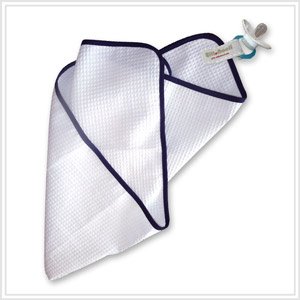Eczema (also known as “atopic dermatitis”) is a skin
condition where allergens or other irritants make your child’s skin itchy, red,
rough, and/or flakey. Doctors sometimes refer to it as “an itch that
rashes” because the scratching or rubbing usually comes before any changes in
the skin. In its mildest form it is often just considered “sensitive skin”, but
in its most severe form it can require hospitalization and serious drugs to
alter a child’s immune system.
In order to prevent an eczema flare, or to relieve mild irritation, it is
important to keep the skin moisturized, as well as avoiding “triggers”
which the skin responds to by becoming inflamed. Common triggers are:
chemicals, harsh soaps or cleaning products, perfumes/fragrances, dyes,
synthetic fabrics (e.g. polyester), wool, sweat, dry air, stress, sudden
temperature changes, and anything the child is allergic to (e.g. food allergies
and/or pet dander).
How do you avoid so many things? For serious eczema,
an allergist can help you identify specific triggers that make your child’s
eczema worse. However, everybody can take some
simple steps to help their child with sensitive skin:
- Daily bath to clean the skin. Eczematous skin gets infected easily, since open areas take away your immune system’s biggest barrier. Use warm water (not too hot or cold), and bath briefly, since long baths can make the skin worse. Use soap-free cleansers (e.g. original Dove bar or Cetaphil). As soon as the child gets out of the bath, pat the skin dry (rubbing makes things worse) and cover it in a layer of moisturizer (ointments lock in the moisture best, which is why so many people love Aquaphor for their sensitive skin).
- Always use dye-free, fragrance-free soaps and cleansers, especially for the laundry. Many people use Dreft detergent for their baby’s clothes, but this is full of chemicals. Run all of the baby’s laundry through an extra rinse cycle to be sure to get rid of any chemical residue.
- Re-apply your moisturizer (e.g. Aquaphor) a few times a day.
- Keep fingernails short to avoid scratching.
- Many older children (and adults) with eczema report their symptoms worsen at night, so make sleeping conditions as comfortable as possible. A cool mist humidifier can help keep the air cool and moist. Use distilled water in the humidifier, do not use any menthol or scented discs in it, and clean out the reservoir with vinegar every 3 days. Children age 2 and older may be helped by taking an antihistamine before bed (discuss this with your pediatrician before giving it to your child).
Babies have a larger
surface area to body mass ratio then older kids/adults, and their skin is
thinner. This makes them especially susceptible to irritants, and you want to
avoid using medicated creams as much as possible, since more is absorbed into
their system then in older children/adults.
A mother whose baby has severe
eczema created a blanket to help relieve her child’s skin irritation, and she
gave me a blanket to try out. It is the Elli & Nooli Organic Cotton
Pique Blanket (http://www.amazon.com/Loopiblanket-Organic-Blanket-Pacifire-Fastner/dp/B008MBMYZ8/ref=sr_1_2?s=baby-products&ie=UTF8&qid=1346005373&sr=1-2&keywords=elli+%26+nooli).

I brought it to work to try with a few patients, and then brought it home to my toddler son. It is designed for infants, but since it is big enough to swaddle them comfortably, it is actually big enough (30” x 40”) to cover my toddler in bed (although he will soon outgrow it). This is now my son’s favorite blanket, and since giving it to him over a month ago, he insists on using it every night to sleep. He reports that it is “comfy”. The certified organic cotton means that it is less irritating than other fabrics, as well as being chemical-free and pesticide-free. The pique weave (tight weave forming raised mini squares all over) keeps air flowing under the blanket, and even allows some air exchange through the blanket. It keeps my child warm, without over-heating, so he is not sweating at night, despite living in a house with no air conditioner during a heat wave (for the past 2 weeks only, we are moving soon). Overall, I really like this blanket, and would recommend it for babies with sensitive skin.

I brought it to work to try with a few patients, and then brought it home to my toddler son. It is designed for infants, but since it is big enough to swaddle them comfortably, it is actually big enough (30” x 40”) to cover my toddler in bed (although he will soon outgrow it). This is now my son’s favorite blanket, and since giving it to him over a month ago, he insists on using it every night to sleep. He reports that it is “comfy”. The certified organic cotton means that it is less irritating than other fabrics, as well as being chemical-free and pesticide-free. The pique weave (tight weave forming raised mini squares all over) keeps air flowing under the blanket, and even allows some air exchange through the blanket. It keeps my child warm, without over-heating, so he is not sweating at night, despite living in a house with no air conditioner during a heat wave (for the past 2 weeks only, we are moving soon). Overall, I really like this blanket, and would recommend it for babies with sensitive skin.
Please note that although this post mentions many brands (e.g. Dove, Cetaphil, Aquaphor, Elli & Nooli), this is NOT a sponsored post, and I have no financial stake in any of these companies.



